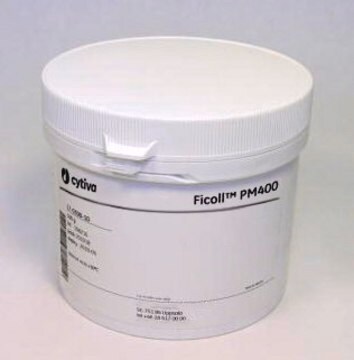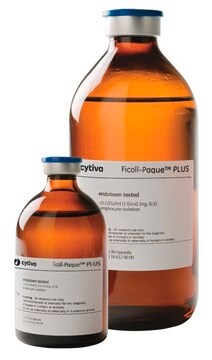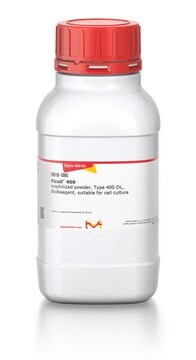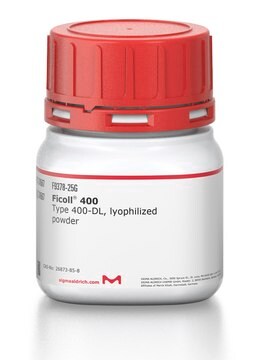GE17-0300-05
Ficoll® PM400
Cytiva 17-0300-05, pack of 5 kg
About This Item
Polecane produkty
Postać
solid
spray-dried
opakowanie
pack of 5 kg
producent / nazwa handlowa
Cytiva 17-0300-05
kolor
White
rozpuszczalność
soluble
Opis ogólny
Ficoll® PM400 is a synthetic neutral, highly-branched hydrophilic polymer of sucrose with an average molecular weight of 400 000. It has long been used to form density gradients for separating and isolating eukaryotic cells, organelles and bacterial cells, as a stabilizing agent, and as a preparation medium for isolating mononuclear cells. Applications can also be found in defined culture media, nucleic acid hybridization, electrophoresis, and immunological studies.
Zastosowanie
It also has applications in defined culture media, nucleic acid hybridization, electrophoresis, and immunological studies.
Used for gradient centrifugation in all types of centrifuge rotors and for separation at unit gravity.
Cechy i korzyści
- For producing density gradients for separation of cells and subcellular components by centrifugation or by sedimentation at unit gravity.
- Neutral, highly branched, hydrophilic polymer of sucrose which dissolves readily in aqueous solution.
- Concentrations of up to 50% (w/v) covering densities of up to 1.2 g/mL can be achieved.
- Better osmotic properties than sucrose.
- Preserves functional and morphological integrity.
- Useful for separating cells that are sensitive to centrifugation and for separating cells of similar density but different size (under conditions of sedimentation at unit gravity).
- Does not penetrate biological membranes.
- Serves as the raw material for preparation of Ficoll-Paque gradients.
- Used in other applications such as electrophoresis, hybridization, cryopreservation, and as a hapten carrier.
Przechowywanie i stabilność
Komentarz do analizy
Informacje prawne
Kod klasy składowania
13 - Non Combustible Solids
Certyfikaty analizy (CoA)
Poszukaj Certyfikaty analizy (CoA), wpisując numer partii/serii produktów. Numery serii i partii można znaleźć na etykiecie produktu po słowach „seria” lub „partia”.
Masz już ten produkt?
Dokumenty związane z niedawno zakupionymi produktami zostały zamieszczone w Bibliotece dokumentów.
Klienci oglądali również te produkty
Produkty
Density Marker Beads are dyed derivatives of Sephadex™. There are ten color-coded bead types, each with a specific density. They have been specifically formulated for use in Percoll gradients and will not work with other media. Using Density Marker Beads as an external marker facilitates monitoring of the gradient shape and range.
The effects of the mononuclear cell separation method described by Bøyum procedure are noted below, since research situations may arise in which they are significant.
Tabela została opracowana, aby pomóc badaczowi w wyborze źródeł, które najprawdopodobniej zawierają istotne informacje dotyczące stosowania Percollu w różnych typach komórek.
This page shows methods to remove Percoll from a sample after centrifugation.
Protokoły
The following procedure has been evaluated with Ficoll-Paque PLUS and is recommended for separation of normal blood samples for maximum reproducibility.
How to use percoll to prepare a gradient
Poniższa procedura została oceniona przy użyciu Ficoll-Paque PLUS i jest zalecana do oddzielania normalnych próbek krwi w celu zapewnienia maksymalnej odtwarzalności.
Aby przygotować gradient Percolla, osmolalność Percolla musi być dostosowana za pomocą soli fizjologicznej lub pożywki do hodowli komórkowej, aby Percoll był izotoniczny z fizjologicznymi roztworami soli.
Powiązane treści
Dane zostały zebrane, aby pomóc badaczowi w wyborze referencji, które najprawdopodobniej zawierają istotne informacje dotyczące stosowania Percoll dla określonego typu komórek lub tkanek.
Nasz zespół naukowców ma doświadczenie we wszystkich obszarach badań, w tym w naukach przyrodniczych, materiałoznawstwie, syntezie chemicznej, chromatografii, analityce i wielu innych dziedzinach.
Skontaktuj się z zespołem ds. pomocy technicznej










